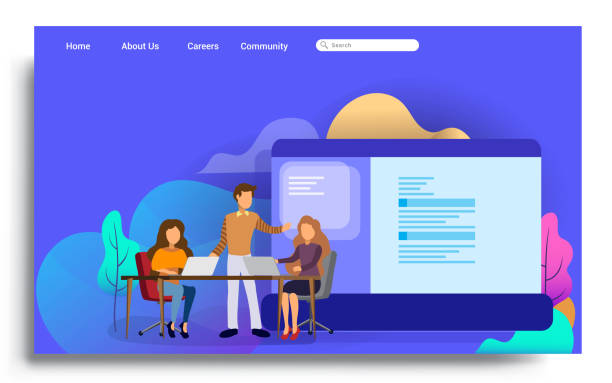Introduction to the Importance of Secure Website Design

In today’s digital world, where businesses and personal information are increasingly transferred to the internet, #security of websites is of vital importance.
An insecure #website can lead to the loss of sensitive data, damage to #data_protection, loss of #user_trust, and even heavy legal penalties.
Therefore, secure website design is no longer a luxury option, but an undeniable necessity for any business or organization intending to operate online.
The goal of this educational and explanatory article is to provide a comprehensive overview of the principles and methods of secure website design.
When it comes to cybersecurity, many only think of strong passwords or complex firewalls, but the truth is that website security goes beyond these and includes various stages from initial design to continuous maintenance.
Creating a secure website requires a deep understanding of existing threats, common vulnerabilities, and best practices for countering them.
This requires attention to details that can make the difference between a website resistant to attacks and an easy target for hackers.
Therefore, every developer and business owner must be familiar with the fundamentals of secure website design.
The topic of secure website design covers a wide range of dimensions, from system architecture to coding, data management, user authentication, and even user behavior.
In this comprehensive guide, we will explore various aspects of this topic to ensure you have the necessary tools to build and maintain a protected website.
The importance of this issue is such that many organizations employ specialized teams solely to ensure the security of their online platforms.
Understanding these aspects not only helps protect information but also increases user trust and ultimately the success of your business.
In the information age, where data is considered the most valuable asset, any security breach can lead to irreparable consequences.
Loss of customer information, exposure of trade secrets, or even website downtime for extended periods, all can harm an organization’s reputation and profitability.
For this reason, investing in secure website design and adhering to security standards is a smart and vital decision for any organization.
In the following chapters, we will delve deeper into each of these aspects to provide a complete picture of this important field.
Did you know that 85% of customers check your company’s website before any interaction?
With Rasawweb, build a corporate website that truly reflects your credibility.
✅ Increase credibility and customer trust
✅ Attract high-quality leads
⚡ Get free website design consultation
Common Cyber Threats and How to Identify Them

To correctly implement secure website design, we must first become familiar with the types of #cyber_threats and #web_attacks that target websites.
Understanding #vulnerabilities and attack methods helps us implement more effective defenses.
One of the most common attacks is SQL Injection, where an attacker gains access to the database by using malicious code in user inputs.
This attack can lead to data theft, modification, or deletion, and is of high importance in the context of secure website design.
Another very common attack is called XSS (Cross-Site Scripting).
In this type of attack, the attacker injects malicious script codes into the website, which are then executed by the visiting users’ browsers.
This can lead to the theft of cookies, session information, or even redirecting users to phishing pages.
To prevent XSS, meticulous validation of user inputs and secure outputs are of high importance and must be considered during the secure website design stages.
This section of the article addresses these threats with an analytical and specialized approach.
DDoS (Distributed Denial of Service) attacks are also a serious threat to website stability.
In these attacks, the perpetrator overwhelms the website server with a massive volume of fake traffic, making it inaccessible to legitimate users.
Countering DDoS requires robust infrastructure, Content Delivery Networks (CDNs), and specialized firewalls.
Early detection of these attacks and having an emergency response plan are essential for secure website design.
In addition, phishing attacks, Brute-Force attacks, and social engineering are other significant threats.
Identifying these threats and understanding how they work is the first step in secure website design.
To counter these threats, a comprehensive and layered approach to website security is necessary, including regular updates, continuous monitoring, user education, and the use of advanced security tools.
These comprehensive approaches can be considered a practical guide for secure web configuration.
Basic Principles of Secure Site Design from Coding to Infrastructure

Secure website design requires adherence to #security_principles from the very initial stages of #secure_coding to #server_configuration and infrastructure.
The first and most important principle is the “Security by Design” approach; meaning that security must be considered at every stage of the Software Development Life Cycle (SDLC), rather than being added as an afterthought upon completion of development.
This specialized and guidance approach ensures that security foundations are at the core of the system.
In the realm of coding, Input Validation is of high importance.
Any data received from the user must be carefully examined and sanitized to prevent the injection of malicious code.
Using secure frameworks and libraries, which have built-in security mechanisms, can significantly reduce risks.
Furthermore, adhering to the principles of OWASP Top 10, which lists the most common web vulnerabilities, is essential for any developer seeking secure website design.
This list provides a vital checklist for reviewing web application security.
From an infrastructure perspective, Server Hardening is a fundamental step.
This includes removing unnecessary services, closing unused ports, and regularly updating the operating system and server software.
The use of network firewalls and intrusion detection systems is also vital for protecting the server against unauthorized access.
Furthermore, special attention must be paid to managing access and privileges of system users.
Update and Patch Management is also among the basic principles.
Every software, from the operating system to Content Management Systems (CMS) and plugins, must be regularly updated to address known security vulnerabilities.
Neglecting this can expose your website to cyberattacks.
The table below provides a summary of basic principles in secure web development:
| Title | Description | Importance |
|---|---|---|
| Security by Design | Incorporating security considerations into every phase of development. | Very High |
| Input and Output Validation | Sanitizing and validating input and output data. | Very High |
| Patch and Update Management | Regular installation of security updates for all software. | High |
| Secure Server Configuration | Reducing server attack surface by disabling unnecessary services. | Very High |
| Access and Privilege Management | Granting the principle of least privilege. | High |
Using version control systems like Git can also help track code changes and revert to stable versions in case of issues.
Furthermore, implementing robust logging and monitoring mechanisms is essential for identifying suspicious activities on the website.
These principles contribute to forming a strong infrastructure for secure website design and protect your website against a wide range of threats.
The Role of SSL/TLS Certificates and HTTPS Protocol in Site Security

In the discussion of secure website design, the importance of #SSL (Secure Sockets Layer) and #TLS (Transport Layer Security) and the #HTTPS (Hypertext Transfer Protocol Secure) protocol cannot be overlooked.
These technologies are the backbone of secure communications on the internet and protect data exchange between the user’s browser and the website server by providing strong #encryption.
This section takes an explanatory and educational approach to the role of these protocols.
When a website uses HTTPS, all data exchanged between the user and the server is encrypted.
This means that even if an attacker manages to eavesdrop on this traffic, they will not be able to read or interpret the information, as the data is unintelligible and encoded.
This feature is crucial for protecting sensitive information such as usernames, passwords, credit card details, and personal data.
Without HTTPS, this information is sent in plain text and can be easily stolen.
An SSL/TLS certificate is what enables HTTPS communication.
This certificate is issued by a trusted Certificate Authority (CA) and verifies the website’s identity.
The presence of this certificate assures users that they are connecting to the legitimate website and not a fake or phishing site.
This #trust of users is crucial for any business seeking online stability and growth, and is an integral part of secure website design.
In addition to security aspects, using HTTPS also has other benefits.
Search engines like Google prefer websites that use HTTPS in their search results rankings (SEO).
This means that a more secure website not only provides better protection but also has a greater chance of being seen and attracting traffic.
Migrating from HTTP to HTTPS is an essential step for any website that wants to remain competitive and secure in today’s online environment.
Proper implementation of this technology is one of the main components of secure web configuration.
The SSL/TLS implementation process includes purchasing the certificate, installing it on the web server, and configuring the website to use HTTPS.
This process has its own complexities and must be carried out carefully to prevent security errors or access issues.
However, investing in this area is entirely justifiable, as its security and credibility benefits far outweigh the initial costs.
This is a long-term investment in your website’s stability and credibility, considered a fundamental step within the framework of secure website design.
Tired of your company’s website not being seen as it deserves, and losing potential customers? With professional and effective website design by Rasawweb, solve this problem forever!
✅ Increase brand credibility and gain customer trust
✅ Attract targeted sales leads
⚡ Contact us now for a free consultation!
Authentication and Access Control Management in Websites
![]()
One of the most important aspects of secure website design is #authentication_management and #access_control for users.
These processes ensure that only authorized users can access specific parts of the website and perform authorized actions.
This is crucial for any website with user accounts, administrative panels, or sensitive information, and requires a specialized and guidance approach.
Authentication is the process of verifying a user’s identity.
This typically involves entering a username and password.
To enhance security, it is recommended to use Two-Factor Authentication (2FA).
2FA adds another layer of security that makes it difficult for an attacker to access the user account even if the password is stolen.
Secure password storage, using strong hashing algorithms and salting, is also of high importance to prevent dictionary and Brute-Force attacks.
After authentication, Access Control (Authorization) comes into play.
This process determines what resources an authenticated user has access to and what operations they can perform.
Implementing Role-Based Access Control (RBAC) models is highly effective.
In RBAC, instead of assigning access to each user individually, permissions are assigned to roles (such as administrator, editor, regular user), and then users are assigned to these roles.
This makes #user_management simpler and more secure.
Another important point in secure website design in this area is Session Management.
Sessions must be securely maintained, have appropriate expiration times, and be immediately invalidated upon user logout.
Using secure and encrypted tokens for session management is recommended.
Furthermore, CSRF (Cross-Site Request Forgery) attacks must be prevented by using CSRF tokens and validating the Referer header.
Failure to correctly adhere to authentication and access control principles can lead to unauthorized access to sensitive information or administrative capabilities, with irreparable consequences.
Therefore, investing in the precise implementation and continuous testing of these mechanisms to ensure proper functionality and resistance to attacks is a vital part of the site protection process.
These principles help enhance overall system security and support secure website design.
Database Security and Preventing SQL Injection Attacks

Databases are the heart of many websites and contain vital user and business information.
Therefore, #database_security is an integral component of secure website design.
One of the most destructive and common attacks against databases is #SQL_Injection, where the attacker injects malicious SQL code into the website through user inputs.
This section provides a specialized and guidance approach to #data_protection in databases.
To prevent SQL Injection attacks, the most important step is to use Prepared Statements or ORMs (Object-Relational Mappers) with parameterized queries.
These methods ensure that user input is interpreted as data, not as part of the SQL command, thereby preventing the execution of malicious code.
User input data should never be directly inserted into SQL queries without validation.
Furthermore, applying the Principle of Least Privilege for database users is crucial.
This means that any user accessing the database (whether system user or application) should only have the minimum necessary privileges to perform their tasks.
For example, a web application for reading and writing data does not need administrative privileges or permissions to delete tables.
Encrypting sensitive data in the database, such as passwords (using hashing and salting) and personal user information, provides an additional layer of defense against data breaches.
Even if an attacker gains access to the database, the encrypted data will not be usable for them.
Also, ensuring that the database is accessible over the network only from authorized IP addresses and required services can limit attacks.
Regularly updating the Database Management System (DBMS) and applying security patches is also of high importance.
Many known vulnerabilities exist in older versions that are resolved with updates.
Regular backups of the database and storing them in a secure and separate location are crucial for data recovery in case of an attack or system failure, and are an integral part of secure web development and secure website design.
These comprehensive measures provide a strong defensive strategy for protecting your valuable data.
Review of Web Application Firewalls (WAF) and Intrusion Detection Systems

Within the framework of secure website design and creating multiple layers of defense, #Web_Application_Firewalls (WAFs) and #Intrusion_Detection_Systems (IDS) and Intrusion Prevention Systems (IPS) play a vital role.
These tools act as intelligent guardians, monitoring incoming and outgoing website traffic to identify and block malicious attacks.
This section provides an analytical and specialized view on these #security_systems and how to implement #defense_in_depth.
WAF operates at the application layer of the OSI model and is specifically designed to protect web applications against common attacks such as SQL Injection, XSS, CSRF, and other OWASP Top 10 vulnerabilities.
WAF analyzes HTTP/HTTPS requests and applies a set of rules to identify and block suspicious traffic.
This is a highly effective defensive layer that can stop many known attacks before they reach the website server.
IDS (Intrusion Detection System) monitors network traffic to identify suspicious patterns or violations of security rules.
IDS merely alerts and does not block traffic, but IPS (Intrusion Prevention System), in addition to detection, is also capable of blocking malicious traffic.
IPS can be positioned in-line with traffic and take preventative action.
These systems can detect DDoS attacks, port scans, and other intrusive activities.
A strong security strategy for secure website design includes combining WAF and IDS/IPS.
WAF protects the application against specific web attacks, while IDS/IPS covers lower network and operating system layers.
This layered approach, also known as Defense in Depth, ensures that even if one security layer is breached, other layers can still protect the system.
Correct selection and configuration of these tools are crucial for site protection.
WAF rules must be regularly updated, and IDS/IPS must also be familiar with new attack patterns.
Implementing these systems requires specialized knowledge, but investing in them can significantly reduce costs resulting from security breaches.
The table below provides a comparison between WAF and IDS/IPS:
| Feature | WAF (Web Application Firewall) | IDS/IPS (Intrusion Detection/Prevention System) |
|---|---|---|
| Operating Layer | Layer 7 (Application) | Layers 3 and 4 (Network) |
| Main Goal | Protecting web applications against specific web attacks (SQLi, XSS, CSRF) | Detecting/Preventing intrusion at the network and system level |
| Method of Operation | Analyzing HTTP/HTTPS requests | Monitoring network traffic for attack patterns |
| Action Capability | Blocking specific malicious requests | IDS: Alert only; IPS: Block traffic |
| Coverage | Web application attacks | Attacks on network infrastructure and operating system |
Using these tools, especially in conjunction, can significantly elevate your website’s security level and contribute to secure website design.
These systems continuously monitor traffic and take necessary actions to prevent harm upon detecting any suspicious patterns.
This defensive approach makes the website more resilient against new and complex threats.
Penetration Testing and Vulnerability Assessment

After implementing the principles of secure website design, the next step is to ensure the effectiveness of these defensive mechanisms.
This is where #penetration_testing (Pentest) and #vulnerability_assessment play a vital role.
These processes, in a specialized and guidance manner, help identify weaknesses and security loopholes in the website before attackers can exploit them.
This significantly contributes to #proactive_security.
Vulnerability assessment is the process of automatically or manually identifying security weaknesses in a system or application.
This involves using automated vulnerability scanning tools and manually reviewing configurations, code, and business logic.
The primary goal of these assessments is to compile a comprehensive list of existing vulnerabilities along with their risk levels.
These assessments can be performed regularly throughout the website development lifecycle to prevent the emergence of new vulnerabilities.
In contrast, penetration testing is a controlled simulation of a real cyber attack performed by security experts (ethical hackers).
The goal of penetration testing is to discover vulnerabilities and exploit them to demonstrate the real impact of an attack.
This can involve attempting to access sensitive data, elevate privileges, or even bring down the website.
Penetration test results provide valuable insights into actual weaknesses and how attackers exploit them.
There are different types of penetration tests: Black Box (attacker has no information about the system), White Box (attacker has access to all information, such as source code), and Gray Box (attacker has limited information).
The choice of penetration test type depends on the organization’s goals and budget.
For any website seeking secure website design and handling sensitive information, regular penetration testing is essential.
After identifying vulnerabilities, the next step is to remediate and fix them.
This includes applying security patches, rewriting vulnerable code, and reviewing configurations.
Then, a re-assessment or re-penetration test should be performed to ensure that vulnerabilities have been fully addressed and no new vulnerabilities have been introduced during the remediation process.
This is an iterative process that continuously improves the website’s security level and is a crucial step in the path of secure website design.
Are you bothered by losing customers due to your e-commerce site’s outdated appearance or slow speed? Rasawweb’s expert team solves these problems with professional e-commerce website design!
✅ Increase customer trust and your brand’s credibility
✅ Stunning speed and excellent user experience
⚡ Get a free consultation with Rasawweb now ⚡
Security Incident Response and Disaster Recovery Planning

Even with the best approaches to secure website design, the likelihood of security incidents is not entirely eliminated.
Therefore, having a comprehensive plan for #security_incident_response (Incident Response) and #disaster_recovery_planning (Disaster Recovery Planning) is crucial.
This section, with a news-oriented and guidance approach, discusses the importance of #crisis_management and #disaster_recovery.
A security incident response plan outlines a set of steps and protocols that an organization must follow in the event of a security incident (such as intrusion, data breach, or DDoS attack).
This plan typically includes the following stages: identification of the incident, containment to prevent further damage, eradication to remove the threat, recovery of systems and data to normal operations, and lessons_learned to improve future security measures.
An Incident Response Team should be designated, whose members have defined responsibilities during an incident.
This team must be regularly trained and conduct incident simulation exercises to be adequately prepared for various scenarios.
Internal and external communications (with stakeholders, customers, and legal entities) must also be carefully planned to ensure that information is released correctly and promptly during a crisis.
Disaster Recovery Planning (DRP) focuses on restoring business operations after a catastrophic event, whether it’s a major cyberattack or a natural disaster.
DRP includes strategies for regular data and system backups, storing backups in secure and separate locations, and having a clear plan for system recovery in the shortest possible time.
The goal of DRP is to minimize downtime and ensure business continuity.
Regular testing of incident response and disaster recovery plans is of high importance.
These tests help identify weaknesses in the plan and improve them.
A well-documented and tested plan can make the difference between a minor security breach and a major disaster.
Implementing these plans is a critical investment in your website’s stability and resilience, and demonstrates your commitment to secure website design.
These measures are an integral part of any secure web configuration.
The Future of Secure Site Design and Emerging Trends

The world of cybersecurity is constantly evolving, and with the emergence of new technologies, secure website design must also adapt to these changes.
In this analytical and somewhat entertaining section, we examine emerging trends and future challenges in web security.
#Future_web_security requires continuous vigilance and updating of knowledge and tools.
One of the most important emerging trends is the use of Artificial Intelligence (AI) and Machine Learning (ML) in cybersecurity.
AI/ML can be used to identify unusual behavioral patterns, predict attacks, and automate responses to security incidents.
These technologies can identify and respond to threats much faster and more efficiently than humans, ultimately contributing to the advancement of secure website design.
Serverless Computing is also an emerging trend that brings new security challenges and opportunities.
In this model, developers do not need to manage servers, but the responsibility for the security of code and serverless function configurations still lies with them.
API security, which gains more importance in microservices-based and serverless architectures, will also be a key point for secure web development in the future.
Blockchain technology also has great potential to enhance the security of websites and platforms.
By leveraging the decentralized and immutable nature of blockchain, authentication systems, identity management, and data tracking can be made significantly more secure.
Although its widespread implementation is still in early stages, it is an attractive area for #innovation in web security.
The increase in targeted and complex attacks (APT – Advanced Persistent Threats) and the emergence of new malware further emphasize the importance of continuous education and increased security awareness for developers and users.
Additionally, data privacy regulations such as GDPR and CCPA underscore the importance of data_protection and transparency in collecting and processing user information.
Secure website design in the future will be increasingly tied to these legal and ethical frameworks.
These discussions raise thought-provoking content regarding future challenges, to which the answers require novel approaches.
In summary, the future of secure website design hinges on embracing new technologies, vigilance against evolving threats, and a commitment to a comprehensive and multi-layered approach.
Websites that can adapt to these changes will lead the competition and gain more user trust.
Frequently Asked Questions
| Row | Question | Answer |
|---|---|---|
| 1 | What is secure website design? | Secure website design is a process in which websites are built with security measures in mind from the initial stages of development to protect against cyberattacks, unauthorized access, and data loss. |
| 2 | Why is secure website design important? | Site security is crucial for maintaining user trust, protecting sensitive information (personal and financial), preventing damage to brand reputation, and complying with privacy and security regulations (such as GDPR). A security breach can lead to financial and legal damages. |
| 3 | What are the most common cyberattacks a website faces? | Some of the most common attacks include SQL Injection, Cross-Site Scripting (XSS), Distributed Denial of Service (DDoS), Brute Force, and Credential Stuffing attacks. |
| 4 | What is SQL Injection and how to prevent it? | SQL Injection is a type of attack where the attacker attempts to manipulate the database or extract information by injecting malicious SQL code into the site’s inputs. To prevent it, you should use Prepared Statements/Parameterized Queries, ORM (Object-Relational Mapping), and meticulous input validation. |
| 5 | What is Cross-Site Scripting (XSS)? | XSS is a type of attack where the attacker injects malicious scripts (usually JavaScript) into web pages that are then executed by other users’ browsers. This can lead to the theft of cookies, session information, or alteration of the website’s appearance. |
| 6 | How can Brute Force attacks on login pages be prevented? | To prevent Brute Force attacks, you should use CAPTCHA, limit the number of failed login attempts (Account Lockout), Two-Factor Authentication (2FA), and use complex and long passwords. |
| 7 | What is the role of HTTPS in website security? | HTTPS encrypts the communication between the user’s browser and the website server using SSL/TLS. This prevents eavesdropping, tampering, or forgery of information during transmission and increases user trust. |
| 8 | What is the importance of Input Validation in security? | Input validation is the process of checking and sanitizing data entered by the user. This prevents the injection of malicious code, XSS attacks, SQL Injection, and other vulnerabilities, ensuring that data conforms to the expected format. |
| 9 | Why are regular updates of website systems and software essential? | Regularly updating the operating system, CMS (like WordPress), plugins, themes, and libraries used resolves known security vulnerabilities. Hackers often exploit weaknesses in outdated software for intrusion. |
| 10 | What role do regular backups play in secure website design? | Regular and tested backups of website data (database and files) are a critical layer of defense against data loss due to cyberattacks, human errors, or hardware failures. This allows for rapid website recovery in the event of a disaster. |
And other advertising agency services by Rasawweb in the field of advertising
Smart Direct Marketing: An effective tool for campaign management with dedicated programming.
Smart Marketing Automation: A new service to enhance customer behavior analysis through attractive UI design.
Smart Website Development: A fast and efficient solution to boost sales with a focus on dedicated programming.
Smart Social Media: A new service to enhance digital branding through the use of real data.
Smart Advertising Campaign: A professional solution for customer behavior analysis focusing on intelligent data analysis.
And over hundreds of other services in internet advertising, advertising consultation, and organizational solutions
Internet Advertising | Advertising Strategy | Advertorial
Resources
? Are you ready to transform your business in the digital world? Rasawweb Afarin Digital Marketing Agency, by offering comprehensive services including professional e-commerce website design, Search Engine Optimization (SEO), and advertising campaign management, is your partner on the path to achieving online success. Contact us today and secure the digital future of your business.
📍 Tehran, Mirdamad Street, next to Bank Markazi, Kazerun South Alley, Ramin Alley No. 6




